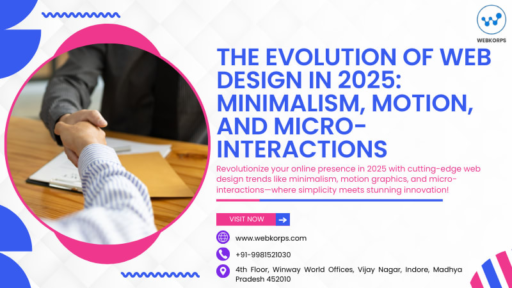Web design has always been a cornerstone of the digital experience, shaping how users interact with businesses and their online platforms. In 2025, web design continues to evolve, driven by advancements in technology, changes in user expectations, and the ongoing integration of IT solutions and services. Today’s websites are more than static pages—they’re dynamic, interactive, and designed to engage users at every touchpoint. Three significant trends define web design in 2025: minimalism, motion, and micro-interactions. These elements work together to create intuitive and visually appealing websites while complementing the broader goals of IT services and solutions in delivering seamless user experiences.
In this blog, we’ll explore how these trends are shaping the future of web design, their benefits, and how businesses, especially those in IT, can leverage them to stay ahead in the digital landscape.
The Rise of Minimalist Design
Minimalist design has been a prevailing trend for years, but in 2025, it has reached new heights. Minimalism focuses on simplicity, clarity, and functionality, removing unnecessary elements to prioritize what truly matters: content and usability.
Key Features of Minimalist Design
Simplified Layouts: Clean and straightforward designs that emphasize essential elements like text, images, and call-to-action buttons.
Whitespace: Generous use of whitespace to create breathing room and guide users’ focus.
Neutral Color Palettes: Soft, muted tones dominate, creating a calming and professional appearance.
Benefits for Businesses and IT Services
The minimalist design aligns perfectly with IT solutions by emphasizing functionality and efficiency. Websites built with minimalism in mind load faster, improving user experience and search engine rankings. Additionally, the reduced visual clutter ensures accessibility and usability, allowing businesses to cater to a wider audience.
For IT service providers, minimalist design reflects professionalism and technical expertise, making it easier to present complex solutions in a digestible format.
The Growing Impact of Motion Graphics
Motion graphics have become a vital tool in web design, adding an interactive and dynamic element to websites. In 2025, motion is not just an aesthetic choice but a strategic feature to guide user interactions and tell a story.
Applications of Motion Graphics in IT Solutions
Interactive Product Demos: IT companies use motion graphics to showcase their services, such as cloud solutions or software functionality, engagingly.
Background Animations: Subtle motion in backgrounds can create a sense of depth and modernity.
Storytelling with Visual Cues: Motion graphics can guide users through complex processes, such as how an IT solution integrates with existing systems.
Benefits of Motion Graphics
Motion graphics improve engagement by drawing attention to key elements on a page. They also enhance storytelling, allowing IT services to convey technical concepts visually, which is particularly useful for non-technical audiences.
However, it’s crucial to strike a balance. Overusing motion can slow down websites and distract users, which is counterproductive to the goals of IT solutions that prioritize performance and efficiency.
The Power of Micro-Interactions
Micro-interactions are the small, subtle animations that users often overlook but greatly enhance their experience. In 2025, micro-interactions are integral to creating intuitive and seamless web designs.
Examples of Micro-Interactions
Button Animations: Buttons that change color or animate when hovered over provide feedback and encourage clicks.
Loading Indicators: Animated spinners or progress bars reduce perceived waiting times.
Hover Effects: Highlighting text or images on hover improves navigation and interactivity.
Enhancing IT Services with Micro-Interactions
For IT companies, micro-interactions play a key role in building trust and usability. For example:
Service Dashboards: Micro-interactions can make navigating complex dashboards intuitive and user-friendly.
Error Feedback: Clear, animated feedback for errors ensures users understand issues and how to resolve them.
Onboarding Experiences: Step-by-step animations during onboarding improve the user’s understanding of IT solutions.
Micro-interactions contribute to a polished and professional experience, helping IT services showcase their expertise in providing seamless digital experiences.
The Synergy of Minimalism, Motion, and Micro-Interactions
In 2025, the most successful web designs combine minimalism, motion, and micro-interactions. Together, these elements create websites that are visually appealing, highly functional, and user-centric.
How They Work Together
Minimalism provides the foundation by stripping away unnecessary elements, ensuring the design is clean and focused.
Motion graphics add personality and depth, capturing attention and guiding users through the site.
Micro-interactions enhance usability, ensuring users feel in control and engaged at every step.
For businesses offering IT services and solutions, this synergy is particularly effective. It allows them to present technical information in a clear, engaging way while maintaining a professional image.
The Role of IT Solutions in Modern Web Design
IT solutions and services play a critical role in enabling these design trends. Advanced tools and technologies make it possible to implement minimalism, motion, and micro-interactions seamlessly.
Key Contributions of IT Services
Optimized Performance: IT services ensure that motion graphics and micro-interactions don’t compromise website performance. Tools like Content Delivery Networks (CDNs) and caching systems help maintain speed and reliability.
Scalable Solutions: IT providers offer scalable hosting and backend solutions to support modern web designs, ensuring they can handle traffic spikes and data-intensive features.
Enhanced Security: By integrating advanced security measures, IT services protect websites from vulnerabilities, ensuring user trust and compliance with regulations.
Future Trends Enabled by IT Services
Looking ahead, IT solutions are expected to integrate emerging technologies like AI, machine learning, and AR/VR into web design. These innovations will further enhance user experiences, providing personalized and immersive interactions.
Future Trends in Web Design Beyond 2025
While minimalism, motion, and micro-interactions are at the forefront of web design in 2025, the future holds even more exciting possibilities:
AI-Driven Design: AI will play a larger role in automating design processes, creating personalized user experiences, and optimizing layouts based on user behavior.
Immersive AR/VR Experiences: As AR and VR technologies mature, websites will become more immersive, offering users virtual tours, interactive product demos, and enhanced shopping experiences.
Web 3.0 and Decentralization: With the rise of blockchain and Web 3.0, web design will shift towards decentralized platforms, requiring new approaches to design and user interaction.
Conclusion
Web design in 2025 is a perfect blend of aesthetics and functionality, driven by trends like minimalism, motion, and micro-interactions. These elements are transforming websites into interactive, intuitive, and visually stunning platforms that meet the demands of modern users.
For businesses in IT services and solutions, embracing these trends is essential to stay competitive and deliver exceptional user experiences. By leveraging cutting-edge tools and technologies, IT companies can create websites that not only look great but also perform flawlessly.
As the digital landscape continues to evolve, staying ahead in web design requires a commitment to innovation and user-centricity. By combining design trends with robust IT solutions, businesses can ensure their websites remain relevant, engaging, and effective in the years to come.







